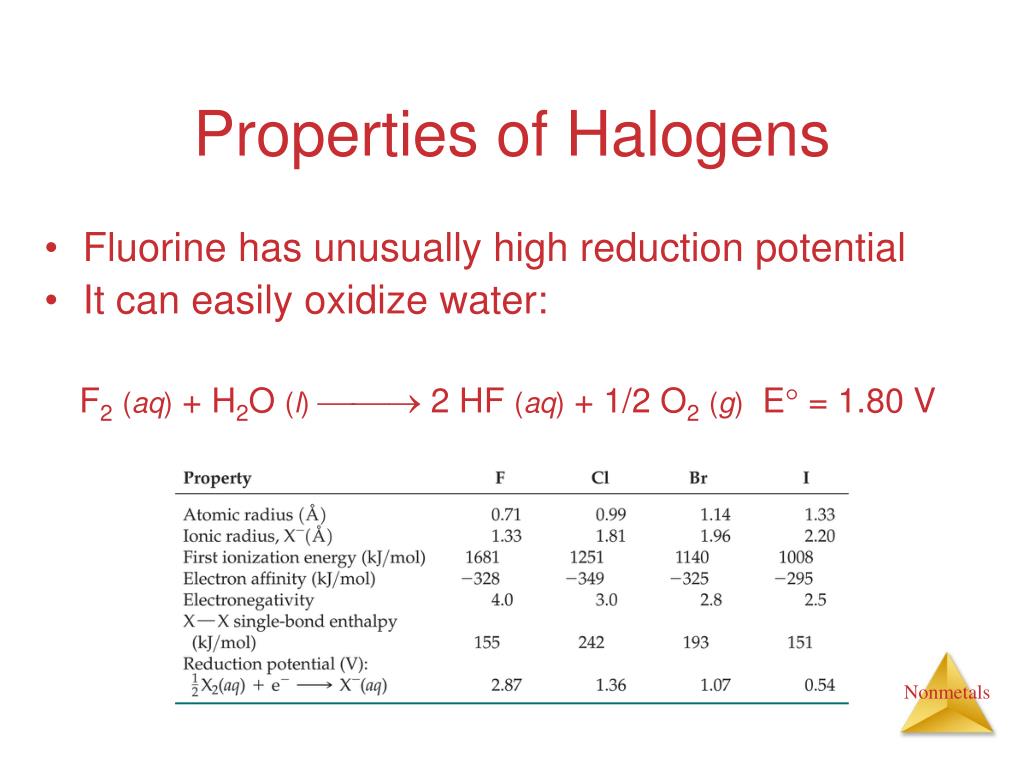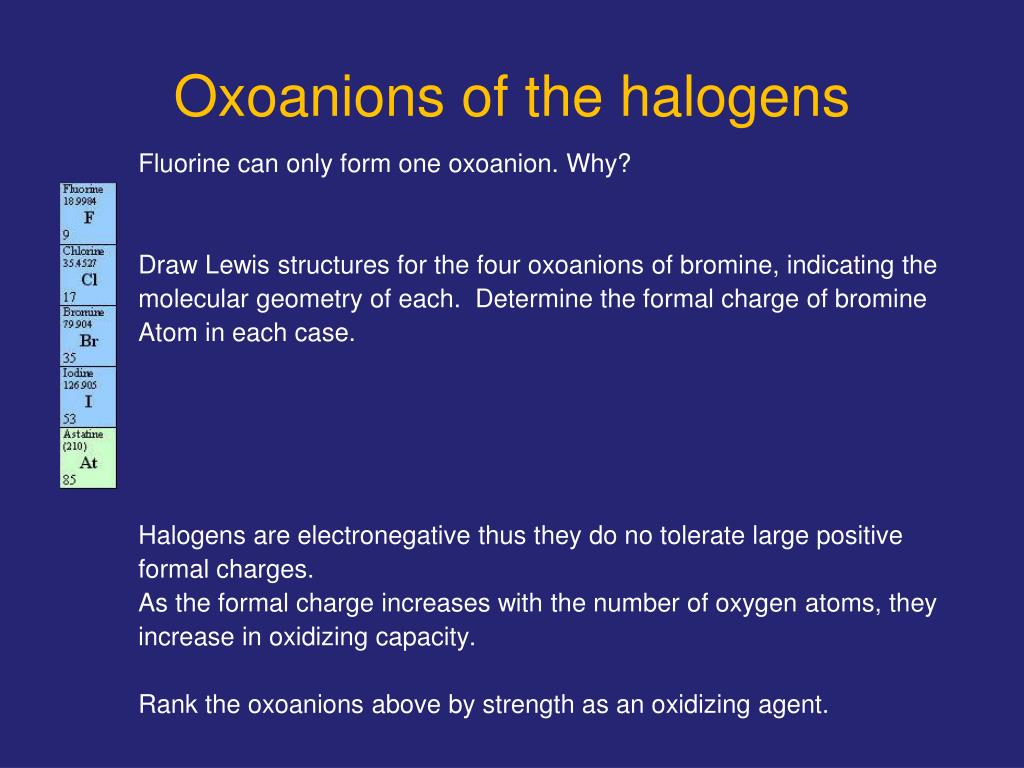Halogens Tend To Form Anions Because
Halogens Tend To Form Anions Because - Halogens have 7 electrons in their valence shell, so they tend to gain 1 electron to fill their octet. Web all of the halogens form acids when bonded to hydrogen. B) gaining electrons will make them attain a. However, you aren't likely to see a naked xx+ x x +. The halogens tend to form anions because. The halogens do exist in the +1 oxidation state, for example, in oclx− o c l x −. B) gaining electrons will fill their octet faster than losing them. Web halogens (flourine, chlorine, bromine, iodine, astatine) and oxygen tend to form anions when bonding with other elements. 2) have 7 valence electrons and need one more. Web halogenation is a term that refers to a chemical process that involves the addition of one or more halogens to a substance or a compound.
Web c) halogen element ionization energies are lower than transition metal ionization energies. Web the halogens tend to form 1+ ions because they only need one electron to fill their valence shell. Halogens tend to form anions because a) losing electrons will fill their octet faster than gaining them. D) halogen atomic radii tend to be larger than their corresponding ionic radii. The halogens do exist in the +1 oxidation state, for example, in oclx− o c l x −. Web + anions + chemistry. However, you aren't likely to see a naked xx+ x x +. They have low electron affinities c. Web answered • expert verified. Web all of the halogens form acids when bonded to hydrogen.
It is a subtle matter. D) halogen atomic radii tend to be larger than their corresponding ionic radii. New york omvm omv η λίσοι estemos question 7 of 25 halogens tend to form anions because a) losing electrons. Most halogens are typically produced from minerals or salts. They have low first ionization energies b. Web answered • expert verified. 2) have 7 valence electrons and need one more. However, you aren't likely to see a naked xx+ x x +. Web halogenation is a term that refers to a chemical process that involves the addition of one or more halogens to a substance or a compound. Web se cr ar ar the halogens tend to form anions because a.
Solved tion 4 of 34 Classify each by whether they are, or
B) gaining electrons will fill their octet faster than losing them. Web halogens tend to form anions because a) losing electrons will fill their octet faster than gaining them. C) anions are usually larger than their corresponding atom. Web halogens tend to form anions because a) losing electrons will make them attain a noble gas configuration faster than gaining them..
Constants I Periodic Table Learning Goal To familiar with the
Most halogens are typically produced from minerals or salts. Web the halogens tend to form 1+ ions because they only need one electron to fill their valence shell. Web generally speaking the elements in the top right side of the periodic table (the nonmetals and halogens) tend to form anions. The stoichiometry and route of. Web halogens tend to form.
Cations And Anions List Tips to memorize cations YouTube
Web halogenation is a term that refers to a chemical process that involves the addition of one or more halogens to a substance or a compound. Web se cr ar ar the halogens tend to form anions because a. Well, your question might actually require a direct answer but let me try expounding it in a better understandable way. Choose.
PPT Chapter 22 Chemistry of the Nonmetals PowerPoint Presentation
1) they give up one electron to achieve the octet rule. Web halogens tend to form anions because a) losing electrons will make them attain a noble gas configuration faster than gaining them. Why does halogen tend to form an anion? Web + anions + chemistry. The halogens do exist in the +1 oxidation state, for example, in oclx− o.
Solved Question 32 Which of the following statements about
Web se cr ar ar the halogens tend to form anions because a. As expected, these elements have certain properties in common. Web generally speaking the elements in the top right side of the periodic table (the nonmetals and halogens) tend to form anions. Halogens tend to form anions because a) losing electrons will fill their octet faster than gaining.
Which of the Following Exists as a Polyatomic Molecule
Halogens have 7 electrons in their valence shell, so they tend to gain 1 electron to fill their octet. C) anions are usually larger than their corresponding atom. Well, your question might actually require a direct answer but let me try expounding it in a better understandable way. 2) have 7 valence electrons and need one more. B) gaining electrons.
anion Common anions, their names, formulas and the elements they are
B) gaining electrons will fill. Web halogens (flourine, chlorine, bromine, iodine, astatine) and oxygen tend to form anions when bonding with other elements. Web halogens tend to form anions because a) losing electrons will make them attain a noble gas configuration faster than gaining them. Web 68) a) atoms are usually larger than their corresponding cation b) the halogens tend.
Solved 13Atoms Of The Elements N And P Have Athe Same
0 followers · 0 following joined march 2020; Web halogens (flourine, chlorine, bromine, iodine, astatine) and oxygen tend to form anions when bonding with other elements. Option b halogens have 7. Web + anions + chemistry. Web generally speaking the elements in the top right side of the periodic table (the nonmetals and halogens) tend to form anions.
PPT Group 17 The Halogens PowerPoint Presentation, free download
The halogens tend to form anions because. They have low electron affinities c. Web halogenation is a term that refers to a chemical process that involves the addition of one or more halogens to a substance or a compound. The halogens do exist in the +1 oxidation state, for example, in oclx− o c l x −. Web halogens tend.
Halogens tend to form anions because A) losing
Web 68) a) atoms are usually larger than their corresponding cation b) the halogens tend to form 1+ ions. Choose the false statement ( read carefully ) a. The stoichiometry and route of. Web halogens (flourine, chlorine, bromine, iodine, astatine) and oxygen tend to form anions when bonding with other elements. Option b halogens have 7.
Web + Anions + Chemistry.
C) anions are usually larger than their corresponding atom. They have low electron affinities c. Why does halogen tend to form an anion? It is a subtle matter.
The Middle Halogens—Chlorine, Bromine, And.
They have high electron affinities d. They have low first ionization energies b. Web halogenation is a term that refers to a chemical process that involves the addition of one or more halogens to a substance or a compound. B) gaining electrons will fill their octet faster than losing them.
As Expected, These Elements Have Certain Properties In Common.
D) halogen atomic radii tend to be larger than their corresponding ionic radii. Halogens have 7 electrons in their valence shell, so they tend to gain 1 electron to fill their octet. B) gaining electrons will make them attain a. Most halogens are typically produced from minerals or salts.
To Begin With, Halogens Are Those Elements Found In Group 17 ( Fomerly Group 7) Of The Periodic Table And They Include;
Web se cr ar ar the halogens tend to form anions because a. 0 followers · 0 following joined march 2020; B) gaining electrons will fill their octet faster than losing them. New york omvm omv η λίσοι estemos question 7 of 25 halogens tend to form anions because a) losing electrons.








